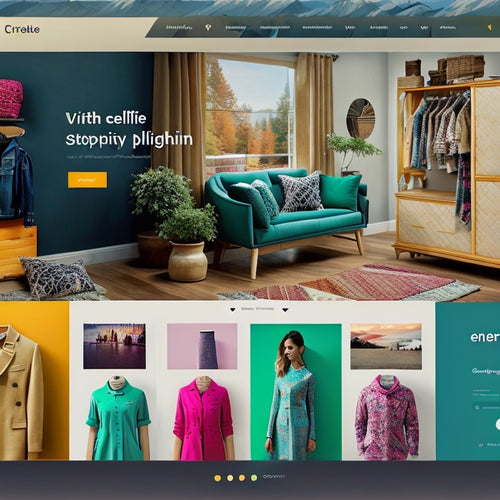
CSS Enhancements Galore: Miva Merchant Guide
Share
Miva Merchant's visual structure and user experience can be greatly enhanced by utilizing a rich set of CSS improvements that offer a strong foundation for customization and adaptability. A well-organized CSS framework allows for smooth responsiveness, while a collection of utilities and practical tools enables developers to refine designs with accuracy. Pre-assembled components and extension libraries expedite development, and adaptable elements enhance website functionality. By leveraging CSS improvements, user-friendly navigation systems can be created, and Miva Merchant modules can be customized to meet business requirements. Explore the full array of possibilities to reveal your online store's genuine capability.
Key Takeaways
• Miva Merchant's well-structured CSS framework enables seamless responsiveness and provides a solid foundation for robust web design.
• A suite of utilities and functional tools empowers developers to fine-tune designs with precision and address styling and layout challenges.
• A pre-built components and extensions library accelerates development and enhances website functionality with customizable elements and features.
• CSS enhancements can be leveraged to craft intuitive navigation systems that support various navigation styles and responsive, adaptive layouts.
• Miva Merchant customization options provide flexibility to tailor functionality to business needs, enhancing overall performance and customer experience.
CSS Elements and Structure
The foundation of a robust and adaptable web design lies in the meticulous crafting of CSS elements and structure, which form the backbone of a website's visual architecture.
A well-structured CSS framework enables seamless responsiveness, ensuring a consistent user experience across various devices and screen sizes.
Responsive layouts are achieved through the clever use of breakpoints, allowing for fluid width adjustments and automatic grid item wrapping.
Keyline styling adds an extra layer of sophistication, providing a clear visual hierarchy through the strategic use of classes like c-keyline, c-keyline--thick, and c-keyline--small.
Utilities and Functional Tools
Beyond the foundational elements of CSS structure, a suite of utilities and functional tools empowers developers to fine-tune their designs with precision, addressing a wide range of styling and layout challenges. These tools enable responsive design, ensuring a seamless user experience across various devices and screen sizes. Additionally, accessibility features are integrated, making it easier to create inclusive designs.
Some key utilities and functional tools include:
-
Border and spacing utilities for precise control over element boundaries and spacing.
-
Display and visibility classes for managing element visibility and display properties.
-
Grid and layout utilities for creating responsive and adaptive grid systems.
- Layering and positioning classes for precise control over element stacking and positioning.
These utilities and functional tools provide developers with the precision and flexibility needed to craft exceptional designs that meet the demands of modern web development.
Components and Extensions Library
Numerous pre-built components and extensions are available in the library, offering a wide range of customizable elements and features to accelerate development and enhance website functionality.
This vast collection includes buttons, control groups, dividers, forms, keylines, and more, allowing developers to create unique interfaces with ease. Custom styling options are endless, with classes for headings, tables, and other elements, ensuring a consistent design language throughout the site.
Interactive features like the Mini-Modal for image display and Hero Slider for captivating visuals are also at your disposal. With a plug-n-play system, integrating these components is a breeze, saving you time and effort.
Navigation and Menu Systems
How do you create navigation and menu systems that enhance user experience and website usability while supporting various navigation styles and layouts?
The answer lies in leveraging CSS enhancements to craft intuitive and responsive navigation systems. Here are some key strategies to achieve this:
-
Dropdown Design: Implement dropdown menus that provide a seamless user experience, especially on mobile devices.
-
Overlay Navigation: Utilize overlay navigation to create mobile-friendly menus that don't clutter the screen.
-
Structured Menus: Organize menus with clear hierarchies and categorizations to facilitate easy navigation.
- Responsive Layouts: Make sure navigation systems adapt to different screen sizes and devices, providing an ideal user experience.
Miva Merchant Customization Options
Customizing Miva Merchant modules enables e-commerce sites to tailor their functionality and features to specific business needs, leveraging a range of available tools and integrations. This flexibility allows online stores to adapt to their unique requirements, enhancing their overall performance and customer experience.
With numerous modules available, such as Instapages, Google Analytics 4, and QR Code Generator, merchants can easily integrate and customize features to suit their needs. The platform's customization features enable seamless module integration, empowering businesses to revamp their online presence.
Frequently Asked Questions
Can Custom CSS Be Used Alongside the Pre-Built Classes and Components?
Yes, custom CSS can be used alongside pre-built classes and components, offering flexibility while maintaining styling consistency and compatibility, but be aware of potential limitations and customization options to guarantee seamless integration.
How Do I Troubleshoot CSS Conflicts With Third-Party Miva Merchant Modules?
When CSS conflicts arise, 'untangle the knot' by employing debugging techniques like inspecting element, browser developer tools, and conflict resolution strategies. Verify module compatibility and custom styling by testing, iterating, and refining your code to resolve issues.
Are There Any CSS Accessibility Guidelines for Screen Readers and Disabilities?
When crafting CSS for accessibility, prioritize semantic HTML structures, ensuring screen readers can interpret content correctly, and implement keyboard navigation to enable seamless interactions for users with disabilities.
Can I Use CSS Preprocessors Like Sass or Less With the Miva Merchant Framework?
'CSS preprocessors like Sass or Less can be used with Miva Merchant, allowing for advanced CSS customization and streamlined development. Compatibility is guaranteed through flexible framework integration, empowering developers to craft unique, accessible designs.'
Are There Any Plans for a CSS Dark Mode or High Contrast Theme Integration?
Ironically, in a world of vibrant colors, the question of darkness arises. Plans for a CSS dark mode or high contrast theme integration are underway, catering to custom themes and user preferences for a personalized experience.
Related Posts
-
Best Practices for Creating Ugc Shoppable Videos
In today's digital landscape, user-generated content (UGC) has become a powerful tool for brands to engage with thei...
-

Top Product Customization Apps for Shopify
The present article aims to explore the top product customization apps available for Shopify, a widely-used eCommerc...
